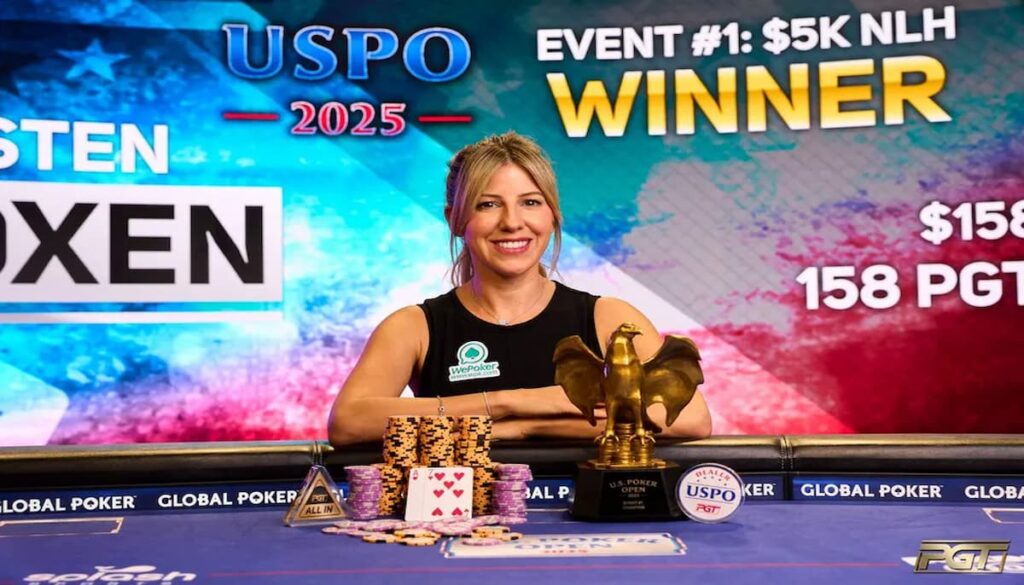The aim of the game in poker is to win as many chips as possible, but this can’t be done without an effective poker tournament strategy.
Poker is one of the most popular games in the world, as it offers the chance to win life-changing sums of money for relatively little investment. Every player enters with dreams of glory – but to go the distance, you need to know how to win online poker tournaments.
How to Play Tournament Poker
The first logical step is to learn how to play Texas Hold’em – the most common form of poker around – then to soak up our tournament poker tips to use in the crucial moments in the game. For example, to have a chance at winning the big prize, your play in the initial rounds will need to differ from your late-stage tournament strategy.
Knowing how to adjust your game based on blinds, how many chips you have, and the strength of your opponents is vital in your quest for success.
Poker Tournament Strategy in Stages
Multi-table tournaments (MTTs) are vastly different to single-table games, as the pool of players is greater. This can mean that they can go on for hours and even days, but this also means that the prize pool is bigger.
Longer tournaments mean more stages, and having good poker tournaments strategy will help you to know when to switch gears and vary your tactics.
If you find yourself wondering how poker tournaments work, familiarize yourself with the variations of the sport before diving into gameplay.
MTT Poker Strategy: Betting
Ultimately, to figure out how to win a poker tournament, you need to know the best poker tournament strategy for betting. Whether bluffing or playing a strong hand, this is where your chip stack either increases or decreases, and decides where you finish in a tournament. Follow these poker tournament tips on betting to give yourself the best chance.
Position
Position is vital when it comes to poker tournament strategy. The position you are in determines the amount of information you can get on an opponent’s poker tournament strategy – and in poker, information is power.
As we already know, each seat at a table can be categorized as either early, middle or late position. This rotates as the dealer moves clockwise, and so you have a chance to be in each position in turn.
All early position seats have the chance to act first in each betting round after the flop. These players have the opportunity to either fold, call or bet – and there is no guaranteed way of knowing what the players acting after them will do in response.
So if a player in an early position decides to call and you’re in a late position, you can choose to check: another card for ‘free’ is more chance for you to make a strong hand.
Increase the Pressure
Alternatively, a poker tournament tip would be to bet at this point and apply pressure to your opponent. This will test whether your opponent wants to call that bet and stay in the hand, knowing that they’ll then have to act before you on the flop which will again give you a chance to suss out their hand strength.
Those in late position have the benefit of seeing what every other player is doing before making their decision – and it’s no surprise that a high proportion of successful players win the majority of their hands from this position. You can try this for yourself in the best online poker tournaments.
Bet Sizing
Bet sizing can make the difference between reaching the final table and being eliminated early. To know how to play online poker tournaments you need to be able to bet accordingly, and this is crucial at two main points in the game: pre-flop and post-flop.
Aggression
Aggression, when employed at the right moment, is an important weapon in your poker tournament strategy arsenal. If you’re consistently limping in from the blinds, checking, folding and rarely raising, you could be perceived by your opponents as being weak or unconfident. A well-timed raise can erase any of these thoughts and is one of the best poker tournament tips.
As your confidence increases, so may the amount of bluffs that you make. Be warned: don’t get carried away! Only use bluffs when you’ve considered your position, whether the story behind the bluff is believable, and your stack size is suitable.
Stack Management in Poker Tournaments
If you want to know how to win a poker tournament, stack management is an important aspect of play that needs to be mastered. In essence, this means that you are aware of how many chips you have and how this compares to your opponents’. Changing blind levels and how this relates to yours and the other players’ stacks is also important to consider.
Live Poker Strategy
Now you know online poker tournament strategy, it’s important to consider some key differences in the real-life version of the game.
A major distinction is the chance to pick up on physical ‘tells’ in the live version of poker. Many opponents give away information about their hand – whether by flinging their chips down when bluffing, or engaging in more conversation when having a good hand. These can be observed when studying a player closely.
A poker tournament strategy is to simply try and not give these signals away – which takes practice.
When playing online, each round of betting is automated and so you don’t have to wonder how big the blind amount is or when to act. In live poker, the temptation to raise, especially when you have a strong hand, can be overwhelming. However, we must wait our turn, because acting out of turn is a huge faux pas in the poker community.
Slower-Paced Poker
One big difference is that live games are much slower compared to online. This is because of the amount of time it takes to shuffle, deal the cards and collect and distribute the pots. Players also take their time when thinking over a move.
Live poker is more of a social occasion: players like to talk, laugh, and enjoy themselves – this contrasts to the all-action nature of the online game.
A tournament poker strategy is to prepare for a live game accordingly: you may be sitting for a long time. Make sure you’ve had a filling, healthy meal, and perhaps get a workout in beforehand to ensure you don’t get itchy feet.
Understanding Poker Tournament Variance
Poker is a game of time and patience. As games can go on for long periods, your poker tournament strategy can vary vastly from stage to the next.
Even if you follow our expert poker tournament tips and play only strong starting hands from the off, there is no certainty that this will correspond with winning lots of hands.
Don’t let this get to you – stick to your guns and, over time, your efforts will be rewarded. Becoming frustrated and taking unnecessary risks can lead to you busting out early – and the grand prize gone with it.
Some tournaments offer the chance to use crypto as currency. You can do so at the best crypto poker sites.
Cash games differ in the sense that the amount of chips you have in the game directly represents real money. For example, a $100 chip on a cash game represents $100 in real life. This can be cashed out at any point during the game.
Some players prefer this as you can see exactly how much winnings you have at any given time.
Poker Tournament Tips
You’ve studied poker tournament strategy, and feel ready to brave the tables. Keep these top tips in mind so you can be successful:
Focus on decision-making: Don’t make the mistake of expecting to win immediately. Instead, focus on studying ABC poker and playing the hands that you know are good. With experience and time, results will follow.
Avoid going on ‘tilt’: This is a poker term for making rash decisions, usually after losing a hand or two. Losing hands is inevitable – don’t let this ruin your game.
Play your position: As we now know, your position at the table is one of the most important things to keep in mind when deciding your poker tournament strategy. Loosen or tighten your hand range depending on what position you’re in, and remember that acting from a late position often gives you an advantage.
Respond to your environment: Your strategy should evolve, change and develop as a tournament progresses, based on stack size, position, stage of the tournament, and your opponents. Remember, all information is power in poker – use everything you can to get to the final table!
Always keep learning: Studying and continuing to get better is unbelievably vital to your success. The more volume you put in, the better you’ll become. Otherwise, you’ll let everyone else pass you! Once you master Texas Hold’em, it’s common to move onto games like Omaha. After that, you can learn how to play Short Deck poker and other more complex games!






